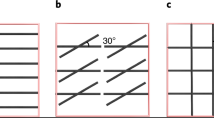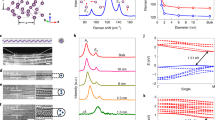Abstract
The construction of soft and processable organic material able to display metallic conduction properties—a large density of freely moving charges—is a major challenge for electronics. Films of doped conjugated polymers are widely used as semiconductor devices, but metallic-type transport in the bulk of such materials remains extremely rare. On the other hand, single-walled carbon nanotubes can exhibit remarkably low contact resistances with related large currents, but are intrinsically very difficult to isolate and process. Here, we describe the self-assembly of supramolecular organic nanowires between two metallic electrodes, from a solution of triarylamine derivative, under the simultaneous action of light and electric field triggers. They exhibit a combination of large conductivity values (>5 × 103 S m−1) and a low interface resistance (<2 × 10−4 Ω m). Moreover, the resistance of nanowires in series with metal interfaces systematically decreases when the temperature is lowered to 1.5 K, revealing an intrinsic metallic behaviour.
This is a preview of subscription content, access via your institution
Access options
Subscribe to this journal
Receive 12 print issues and online access
$259.00 per year
only $21.58 per issue
Buy this article
- Purchase on Springer Link
- Instant access to full article PDF
Prices may be subject to local taxes which are calculated during checkout



Similar content being viewed by others
References
Shirakawa, H., Louis, E. J., MacDiarmid, A. G., Chiang, C. K. & Heeger, A. J. Synthesis of electrically conducting organic polymers: halogen derivatives of polyacetylene, (CH)x . J. Chem. Soc. Chem. Commun. 578–580 (1977).
Heeger, A. J. Nobel lecture. Semiconducting and metallic polymers: the fourth generation of polymeric materials. Rev. Mod. Phys. 73, 681–700 (2001).
Burroughes, J. H. et al. Light-emitting diodes based on conjugated polymers. Nature 347, 539–541 (1990).
Forrest, S. R. The path to ubiquitous and low-cost organic electronic appliances on plastic. Nature 428, 911–918 (2004).
Miller, R. D. & Chandross, E. A. Introduction: materials for electronics. Chem. Rev. 110, 1–2 (2010).
Bredas, J. L. in Handbook of Conducting Polymers Vol. II. (ed. Skotheim, T. A.) 859–913 (Marcel Dekker, 1986).
Stutzmann, N., Friend, R. H. & Sirringhaus, H. Self-aligned, vertical-channel, polymer field-effect transistors. Science 299, 1881–1884 (2003).
McCulloch, I. et al. Liquid-crystalline semiconducting polymers with high charge-carrier mobility. Nature Mater. 5, 328–333 (2006).
Kohlman, R. S. et al. Limits for metallic conductivity in conducting polymers. Phys. Rev. Lett. 78, 3915–3918 (1997).
Lee, K. et al. Metallic transport in polyaniline. Nature 441, 65–68 (2006).
Jerome, D. & Schulz, H. J. Organic conductors and superconductors. Adv. Phys. 31, 299–490 (1982).
Alves, H., Molinari, A. S., Xie, H. & Morpurgo, A. F. Metallic conduction at organic charge-transfer interfaces. Nature Mater. 7, 574–580 (2008).
Crispin, X. et al. Characterization of the interface dipole at organic/metal interface. J. Am. Chem. Soc. 124, 8131–8141 (2002).
Ishii, H., Sugiyama, K., Ito, E. & Seki, K. Energy level alignment and interfacial electronic structures at organic/metal and organic/organic interfaces. Adv. Mater. 11, 605–625 (1999).
Bürgi, L., Richards, T. J., Friend, R. H. & Sirringhaus, H. Close look at charge carrier injection in polymer field-effect transistors. J. Appl. Phys. 94, 6129–6137 (2003).
Meijer, E. J. et al. Scaling behaviour and parasitic series resistance in disordered organic field-effect transistors. Appl. Phys. Lett. 82, 4576–4578 (2003).
Hamadani, B. H. & Natelson, D. Temperature-dependant contact resistances in high-quality polymer field-effect transistors. Appl. Phys. Lett. 84, 443–445 (2004).
Mann, D., Javey, A., Kong, J., Wang, Q. & Dai, H. Ballistic transport in metallic nanotubes with reliable Pd ohmic contacts. Nano Lett. 3, 1541–1544 (2003).
Harutyunyan, A. R. et al. Preferential growth of single-walled carbon nanotubes with metallic conductivity. Science 326, 116–120 (2009).
Green, A. A. & Hersam, M. C. Processing and properties of highly enriched double-wall carbon nanotubes. Nature Nanotech. 4, 64–70 (2009).
Hoeben, F. J. M., Jonkheijm, P., Meijer, E. W. & Schenning, P. H. J. About supramolecular assemblies of π-conjugated systems. Chem. Rev. 105, 1491–1546 (2005).
Schenning, A. P. H. J. & Meijer, E. W. Supramolecular electronics; nanowires from self-assembled π-conjugated systems. Chem. Commun. 3245–3258 (2005).
Percec, V. et al. Self-organization of supramolecular helical dendrimers into complex electronic materials. Nature 419, 384–387 (2002).
Welte, L. et al. Highly conductive self-assembled nanoribbons of coordination polymers. Nature Nanotech. 5, 110–115 (2009).
Samori, P. et al. Self-assembly of electron donor-acceptor dyads into ordered architectures in two and three dimensions: surface patterning and columnar ‘double cables’. J. Am. Chem. Soc. 126, 3567–3575 (2004).
Hill, J. P. et al. Self-assembled hexa-peri-hexabenzocoronene graphitic nanotube. Science 304, 1481–1483 (2004).
Bhosale, R. et al. Topologically matching supramolecular n/p-heterojunction architectures. Angew. Chem. Int. Ed. 48, 6461–6464 (2009).
Moulin, E. et al. The hierarchical self-assembly of charge nanocarriers: a highly cooperative process promoted by visible light. Angew. Chem. Int. Ed. 49, 6974–6978 (2010).
Dayen, J-F. et al. Nanotrench for nano and microparticle electrical interconnects. Nanotechnology 21, 335303 (2010).
Tawfick, S., O'Brien, K. & Hart, A. J. Flexible high-conductivity carbon-nanotube interconnects made by rolling and printing. Small 5, 2467–2473 (2009).
Fitzgerald, E. A., Wuelfing, P. & Richtol, H. H. The photochemical oxidation of some aromatic amines in chloroform. J. Phys. Chem. 75, 2737–2741 (1971).
Hulea, I. N., Russo, S., Molinari, A. & Morpurgo, A. F. Reproducible low contact resistance in rubrene single-crystal field-effect transistors with nickel electrodes. Appl. Phys. Lett. 88, 113512 (2006).
Blech, A. Electromigration in thin films on titanium nitride. J. Appl. Phys. 47, 1203–1208 (1976).
International Technology Roadmap for Semiconductors, Roadmap Information on Interconnects (2009); available at http://www.itrs.net/Links/2009ITRS/2009Chapters_2009Tables/2009_Interconnect.pdf
Kilveson, S. & Heeger, A. J. Intrinsic conductivity of conducting polymers. Synth. Metals 22, 371–384 (1988).
Hong, S. & Myung, S. A flexible approach to mobility. Nature Nanotech. 2, 207–208 (2007).
Kinchin, G. H. The electrical properties of graphite. Proc. R. Soc. Lond. A 217, 9–26 (1953).
Grüner, G. The dynamics of charge-density waves. Rev. Mod. Phys. 60, 1129–1181 (1988).
Egger, R. et al. in Lecture Notes in Physics Vol. 579 (eds Haug, R. & Schoeller, H.) 126 (Springer, 2001).
Lau, C. N., Stewart, D. R., Williams, R. S. & Bockrath, M. Direct observation of nanoscale switching centers in metal/molecule/metal structures. Nano Lett. 4, 569–572 (2004).
Borghetti, J. et al. Electrical transport and thermometry of electroformed titanium dioxide memristive switches. J. Appl. Phys. 106, 124504 (2009).
Pal, S. K. et al. Resonating valence-bond ground state in a phenalenyl-based neutral radical conductor. Science 309, 281–284 (2005).
Haddon, R. C. et al. Localization of spin and charge in phenalenyl-based neutral radical conductors. J. Am. Chem. Soc. 130, 13683–13690 (2008).
Giuseppone, N. Toward self-constructing functional materials. Acc. Chem. Res. http://dx.doi.org/10.1021/ar2002655 (2012).
Acknowledgements
The research leading to these results received funding from the European Research Council under the European Community's Seventh Framework Program (FP7/2007-2013)/ERC Starting Grant (agreement no. 257099, to N.G.). The authors acknowledge the CNRS, the icFRC and the University of Strasbourg for financial support. Support from cleanroom facilities STnano is gratefully acknowledged, as well as the technical support of F. Chevrier, D. Spor, M. Acosta and S. Siegwald. This work was also partly funded by the NanoSciERA programme (project INTERNET, to B.D.), Agence Nationale de la Recherche projects MOSE and SUD (to B.D.), and projects Multiself and STANWs (to B.D., E.M., M.M. and N.G). This work was supported by doctoral fellowships of the French Ministry of Research (V.F., F.N. and J-B.B.) and Région Alsace (S.Z.).
Author information
Authors and Affiliations
Contributions
N.G. conceived the work. V.F, F.N., E.M., J.-F.D., B.D. and N.G. designed the core experiment. V.F., J.-F.D. and B.D. designed the electrodes. E.M. performed the synthesis. V.F. and F.N. performed the initial key experiments, joined subsequently by J-F.D., J.-B.B. and S.Z. to complete and/or reproduce the data. M.M. performed the AFM imaging. B.D. and N.G. wrote the paper. All authors analysed the data, and discussed and commented on the manuscript.
Corresponding authors
Ethics declarations
Competing interests
The authors declare no competing financial interests.
Supplementary information
Supplementary information
Supplementary information (PDF 1404 kb)
Rights and permissions
About this article
Cite this article
Faramarzi, V., Niess, F., Moulin, E. et al. Light-triggered self-construction of supramolecular organic nanowires as metallic interconnects. Nature Chem 4, 485–490 (2012). https://doi.org/10.1038/nchem.1332
Received:
Accepted:
Published:
Issue Date:
DOI: https://doi.org/10.1038/nchem.1332
This article is cited by
-
Light-driven self-assembly of spiropyran-functionalized covalent organic framework
Nature Communications (2023)
-
Supramolecular engineering of charge transfer in wide bandgap organic semiconductors with enhanced visible-to-NIR photoresponse
Nature Communications (2021)
-
Transient dormant monomer states for supramolecular polymers with low dispersity
Nature Communications (2020)
-
Amino-acid-encoded biocatalytic self-assembly enables the formation of transient conducting nanostructures
Nature Chemistry (2018)
-
Anisotropic Thermal Expansion of p-Terphenyl: a Self-Assembled Supramolecular Array of Poly-p-phenyl Nanoribbons
Journal of Superconductivity and Novel Magnetism (2018)



